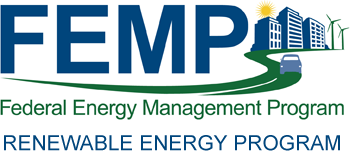Introduction
Within This Page
THIS PAGE SUPPORTED BY THE
The ocean covers 71% of the earth's surface and has the ability to produce two types of energy: thermal energy from the sun's heat, and mechanical energy from the waves and tides. A process called ocean thermal energy conversion generates electricity using the difference in temperature between the warm surface of the ocean and the cold ocean depths. Wave power devices extract energy directly from the surface motion of ocean waves or from pressure fluctuations below the surface. Tidal energy is a form of hydropower that derives its energy from the motion of large bodies of water that make up the tides.
Ocean thermal energy conversion attempts began in the 1880s, but the first plant was not built until 1930 in Cuba. The United States became involved in 1974, establishing the Natural Energy Laboratory of Hawaii Authority (NELHA). Hawaii is the best location in the United States for ocean thermal energy conversion due to the warm surface water, high electricity costs, and access to very deep, cold water. The laboratory has become a leading test facility for this type of technology.
Ocean thermal energy conversion is a resource for onshore and near-shore mariculture operations. It provides air-conditioning for buildings, produces base load electrical energy, and has significant potential to provide clean, cost-effective electricity for the future. However, it requires costly infrastructure to deliver cold water from the depths, and it doesn't produce much power compared to the amount of equipment required. The main attraction is that it produces power day and night, and it does not fluctuate like solar or wind. The National Oceanic and Atmospheric Administration released a paper on this, titled Technical Readiness of Ocean Thermal Energy Conversion (OTEC) .
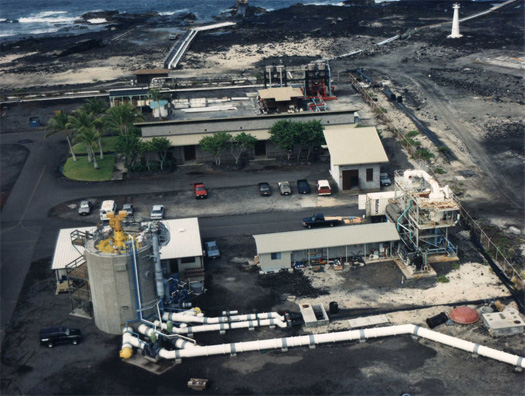
Land-based ocean thermal energy conversion facility
Wave power devices extract energy directly from the surface motion of ocean waves or from pressure fluctuations below the surface. The first known patent to use energy from ocean waves was filed in 1799 in Paris, France. The world's first commercial wave energy plant, at 0.5 megawatts (MW) of power, was developed in Scotland. There are a few areas where wave power may prove desirable, but wave energy is intermittent and variable. Construction of the nation's first wave-energy farm began off the Oregon coast in 2010, but the funding was cut and the project was abandoned. Wave technology is still being developed, but will eventually become competitive with wind and solar.
Some of the oldest ocean energy technologies use tidal power, but there are currently no tidal power plants in the United States. The Rance Tidal Power Station is located on the Rance River in France, and was the first tidal power station starting operation in 1966. Tidal dams create many of the same environmental concerns as damming rivers, such as restricting fish migration and causing a buildup of silt. Although tides are more predictable than wind energy or solar power, it is still intermittent and expensive. A tidal dam might be identical to a river dam, but it will produce less than half the amount of electricity. The construction costs are high and lengthen payback periods. The International Energy Agency has a group dedicated to Ocean Energy Systems which has further information and analyses on various types of ocean energy.
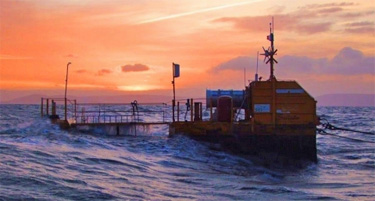
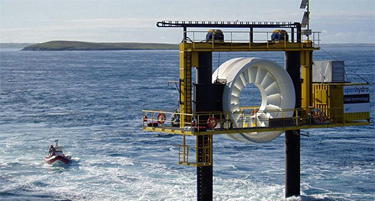
The OE Buoy is designed around the oscillating water column principle. Its turbine captures the energy of the wave and the generator converts this energy to electrical power. A full-scale commercial prototype will have a capacity rating of 1.75 MW.
OpenHydro's Open-Center Turbine was designed to be deployed directly on the seabed. The first 6-m test unit produces enough energy to supply 150 average European homes and save the emission of over 450 tons of carbon dioxide greenhouse gas per year.
This overview is intended to provide specific details for Federal Agencies considering ocean energy as part of a major construction project. Further general information is available from the U.S. Department of Energy (DOE) Office of Energy Efficiency and Renewable Energy (EERE) Marine Energy Basics.
Description
This section provides information on ocean energy systems and reviews the three main types of ocean thermal energy conversion processes.
Ocean Thermal Energy Conversion
An ocean thermal energy conversion system is made up of several key components including:
- Working fluid
- Turbine
- Generator
- Condenser.
There are three types of ocean thermal energy conversion processes: closed-cycle, open-cycle, and hybrid-cycle.
Closed-cycle
In a closed-cycle system, heat transferred from the warm surface water causes a working fluid to turn to vapor. The expanding vapor drives a turbine attached to a generator, which produces electricity. Cold water passing through a condenser, containing the vaporized working fluid, turns the vapor back into a liquid, which is then recycled through the system.
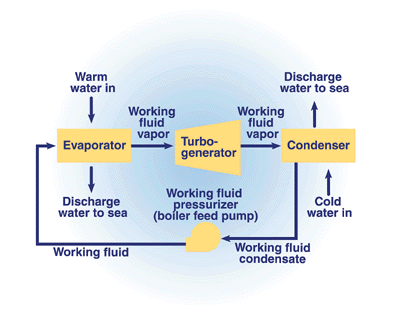
Closed-cycle ocean thermal energy conversion system
Open-cycle
Open-cycle ocean thermal energy conversion uses the warm surface water as the working fluid. The water vaporizes in a near vacuum at surface water temperatures. The expanding vapor drives a low-pressure turbine attached to a generator, which produces electricity. The vapor, which has lost its salt and is almost pure fresh water, is condensed back into a liquid by exposure to cold temperatures from deep ocean water. If the condenser keeps the vapor from direct contact with water, the condensed water can be used for drinking water, irrigation, or aquaculture. A direct contact condenser produces more electricity, but the vapor is mixed with cold water and the discharge water is salty, which is returned to the ocean. The process is repeated with a continuous supply of warm surface water.
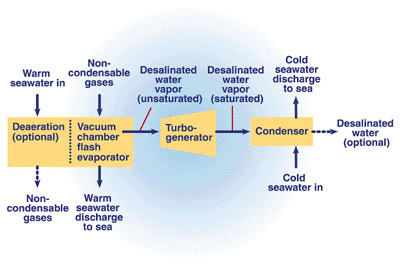
Open-cycle ocean thermal energy conversion system
Hybrid
Hybrid systems use parts of both open- and closed-cycle systems to optimize production of electricity and fresh water.
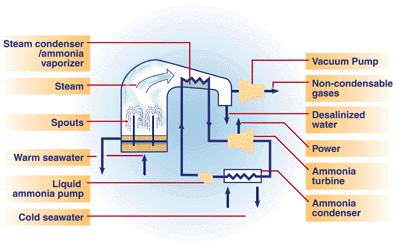
Hybrid ocean thermal energy conversion system
Wave
Wave energy can be converted into electricity through both offshore and onshore systems. Offshore systems are situated in deep water, typically of more than 40 meters (131 feet). Sophisticated mechanisms—like the Salter Duck—use the bobbing motion of the waves to power a pump that creates electricity. Other offshore devices use hoses connected to floats that ride the waves. The rise and fall of the float stretches and relaxes the hose, which pressurizes the water, and, in turn, rotates a turbine.
Specially built seagoing vessels can also capture the energy of offshore waves. These floating platforms create electricity by funneling waves through internal turbines and then back into the sea. Offshore ocean wave generators need anchors to hold them to the sea floor. These generators may actually be beneficial to sea life because of the subsurface structure they provide.
Built along shorelines, onshore wave power systems extract the energy in breaking waves. Onshore ocean wave energy generators will occupy extended lengths of coastline. Most of the coastlines of the world that have significant wave activity are either highly desired residential areas or pristine wilderness.
Tidal
There are three technologies that implement tidal power:
- Barrage or dam
- Sluice
- Turbine
- Generator
- Tidal fence
- Tidal turbine.
A tidal barrage works in a similar way to that of a hydroelectric system, except that the dam is much larger and spans a river estuary. The dam includes a sluice that is opened to allow the tide to flow into the basin; the sluice is then closed, and as the sea level drops, the head of water drives turbines to generate electricity via a generator. Barrages can generate electricity on the ebb side or flood side. The ebb side of an estuary in the northern hemisphere is considered to be the right side looking seaward toward the mouth of the estuary, and the flood side is the left bank looking in the same direction.
Tidal fences and tidal turbines both capture the energy from the tidal streams, which are fast flowing volumes of water caused by the motion of the tide. A tidal fence has vertical axis turbines mounted to a fence, which turn when water is passed through. Tidal turbines are basically wind turbines arrayed underwater in rows that are located anywhere there is a strong tidal flow.
Types and Costs of Technology
The following section discusses the types and costs of ocean energy technology.
Ocean Thermal Energy Conversion
The idea behind ocean thermal energy conversion is not new, but it has not become commercially used due to the high cost of the equipment necessary to build a system. Primary approaches to bringing the cold seawater to the surface include active pumping and desalination. Desalinating the water near the sea floor lowers its density and causes it to rise to the surface.
Lockheed Martin has taken a leading role in progressing with ocean thermal energy conversion. The U.S. Navy has funded the development of the technology. Commercial ocean thermal energy conversion facilities can be built on:
- Land or near the shore
- Platforms attached to the continental shelf
- Moorings or free-floating facilities in deep ocean water.
Land-based or near-shore facilities require less maintenance, do not require lengthy cables, and are relatively safe from storms at sea. These facilities work best to operate with related industries requiring desalinated water. However, these plants are subject to extreme stress during storms, unless the water supply and discharge pipes are buried in protective trenches.
Ocean thermal energy conversion plants can be mounted to the continental shelf in order to avoid this turbulent surf zone. These shelf-mounted facilities are more expensive due to the operation of a plant in deeper water, and are also subject to the stress from open-ocean conditions. These plants are less attractive for near-term ocean thermal energy conversion development.
Floating facilities are more difficult to stabilize, and the cables attached to transmit power are more subject to damage, especially during storms. Mooring is required to connect the plant to power delivery cables, but current mooring technology is limited to 2,000 meters (6,561 feet). The cost of mooring has prohibited commercial ocean thermal energy conversion ventures.
Wave
While all wave energy technologies are installed near the water's surface, they differ in their orientation to the waves, and the manner in which they convert the wave's energy into electricity. Onshore system technologies include: terminator devices, oscillating water columns, tapchans, and pendulor devices. Offshore systems include: attenuators, point absorbers, and overtopping devices.
Terminator devices are oriented perpendicular to the direction of the wave travel. The oscillating water column is a form of terminator that consists of a partially submerged concrete or steel structure that has an opening to the sea below the waterline. It encloses a column of air above a column of water. As waves enter the air column, they cause the water column to rise and fall. This alternately compresses and depressurizes the air column. As the wave retreats, the air is drawn back through the turbine as a result of the reduced air pressure on the ocean side of the turbine.
The tapchan, or tapered channel system, consists of a tapered channel, which feeds into a reservoir constructed on cliffs above sea level. The narrowing of the channel causes the waves to increase in height as they move toward the cliff face. The waves spill over the walls of the channel and into the reservoir, where the stored water is then fed through a turbine.
The pendulor wave-power device consists of a rectangular box, which is open to the sea at one end. A flap is hinged over the opening and the action of the waves causes the flap to swing back and forth. The motion powers a hydraulic pump and a generator.
Attenuators are long floating structures made of multiple segments and are oriented parallel to the direction of the waves. The differing heights of waves along the length of the structure create a flexing between the segments, which drives hydraulic pumps or other converters.
Overtopping devices store incoming waves at a level above the average surrounding ocean and gravity causes it to fall back toward the ocean turning hydro turbines. More information on wave technologies is available from DOE's Marine and Hydrokinetic Technology Development and Testing Program.
Tidal
There are many forms of barrage systems including: ebb generation, flood generation, pumping, two-basin schemes, and tidal lagoon power.
Within an ebb generation system, or outflow generation, water flows through the sluices until high tide. It is stored in the basin until sufficient head has been created across the barrage, and then it is released to run a turbine. Pumping can be used at high tide to increase the water level in the basin. Flood generation is much less efficient than ebb generation, where the water flows through turbines on the way into the basin. A two-basin scheme takes advantage of both ebb and flood flow. These systems are very expensive to construct, due to the extra length of the barrage. Tidal lagoons use impoundment structures to trap the high water and release it to generate power, rather than blocking an estuary with a barrage.
Application
Ocean thermal energy conversion is a potential game-changing energy technology, especially in Hawaii. It is very promising as an alternative energy resource for tropical island communities that rely heavily on imported fuel. These systems could provide islanders with power, as well as desalinated water and a variety of mariculture products. Additionally, ocean thermal energy conversion power can be used to produce energy carriers such as hydrogen, ammonia, and methanol, using large, grazing plantships.
However, this technology is still in the research and development stages, and a number of questions need to be answered before its energy goals can be determined.
There are wave technologies designed to be installed in nearshore, offshore, and far offshore locations, all of which are intended to produce electricity. The OCS Alternative Energy Programmatic Environmental Impact Statement is devoted to offshore and far offshore technologies. Further information on this is discussed in the technology white paper Wave Energy Potential on the U.S. Outer Continental Shelf (PDF 450 KB).
All coastal areas consistently experience two high and low tides over a period of slightly greater than 24 hours. For those tidal differences to be harnessed into electricity, the difference between the high and low tides must be at least 5 meters, or more than 16 feet. There are only about 40 sites on the earth with tidal ranges of this magnitude. The Pacific Northwest and the Atlantic Northeast are locations with tidal potential in the United States.
Tidal fences reach across channels between small islands or across straits between the mainland and an island. Tidal turbines function best where coastal currents run between 3.6 and 4.9 knots (or between 4 and 5.5 miles per hour). In currents of that speed, a 15–meter (49.2–feet) diameter tidal turbine can generate as much energy as a 60–meter (197–feet) diameter wind turbine. Ideal locations for tidal turbine farms are close to shore in water depths of 20 to 30 meters (65.5 to 98.5 feet).
Economics
The following provides specific information on the economic factors to consider for each type of ocean energy system.
Ocean Thermal Energy Conversion
The economics of energy production have delayed the financing of a permanent, continuously operating ocean thermal energy conversion plant. Scientists are developing new, cost-effective turbines for open-cycle ocean thermal energy conversion systems.
Favored locations for ocean thermal energy conversion plants include those with narrow shelves, steep offshore slopes, and smooth sea floors. These sites minimize the length of the pipes, and create easy access for construction and maintenance, which helps to lower the cost of ocean thermal energy conversion-generated electricity. Ocean thermal energy conversion processing plants that produce methanol, ammonia, hydrogen, and other chemicals do not require a power cable, and station operation and maintenance (O&M) costs are reduced.
Wave
Economically, wave power systems have a hard time competing with traditional power sources. However, the costs to produce wave energy are coming down. Some European experts predict that wave power devices will find lucrative niche markets. Once built, they have low operation and maintenance costs because the fuel they use—seawater—is free.
It has been estimated that improving technology and economies of scale will allow wave generators to produce electricity at a cost comparable to wind-driven turbines, which produce energy at about $0.45 per kilowatt hour. For now, the best wave generator technology in the United Kingdom is currently producing energy at an average projected / assessed cost of $0.75 per kilowatt hour.
Resolving intermittency problems to attain reliable energy output can double and even triple the cost of power. The key to reliability and economy of operation is site selection based on good site research.
Tidal
There is a high capital cost for a tidal energy project, with possibly a 10–year construction period. The capital required to start construction of a barrage is the main economic barrier, with long payback periods. The optimum design would produce the most power while minimizing the size of the barrage.
Tidal stream technology is still in the development stages, and therefore is not economically feasible. The cost of using these technologies is very site specific and dependent upon the turbine technology used. Maintenance costs are significant throughout the lifetime of tidal stream technology.
Assessing Resource Availability
The reality of available resources for each type of ocean energy system follows.
Ocean Thermal Energy Conversion
Ocean thermal energy conversion is technically feasible in geographical areas with warm surface water and cold deep water, providing a temperature difference that can be leveraged to produce power. As a result, this technology has the potential to generate electricity for military shore-side bases and communities. NREL performed an economic analysis indicating that over the next 5 to 10 years, ocean thermal energy conversion plants may be competitive in the following areas:
- Small island nations in the South Pacific and the island of Molokai in Hawaii
- 1 MW open-cycle ocean thermal energy conversion plants
- Guam and American Samoa
- 10 MW open-cycle ocean thermal energy conversion plants
- Hawaii
- Large closed-cycle ocean thermal energy conversion plant
- Pacific and Atlantic oceans
- Floating, closed-cycle ocean thermal energy conversion plants.
Wave
Wave power can't be harnessed everywhere. Wave-power-rich areas of the world include the western coasts of most continents. In the Pacific Northwest of the United States alone, it's feasible that wave energy could produce 40 to 70 kilowatts (kW) per meter (3.3 ft.) of western coastline. The West Coast of the United States is more than 1,000 miles long.
In general, careful site selection is the key to keeping the environmental impacts of wave power systems to a minimum. Wave energy system planners can choose sites that preserve scenic shorefronts. They also can avoid areas where wave energy systems can significantly alter flow patterns of sediment on the ocean floor.
The National Centers for Environmental Information keeps track of wave data that is helpful when assessing the resource. It has been estimated that the U.S. wave energy resource is 23 gigawatts (GW).
Tidal
The global distribution of the mean tidal range is shown in the figure below.
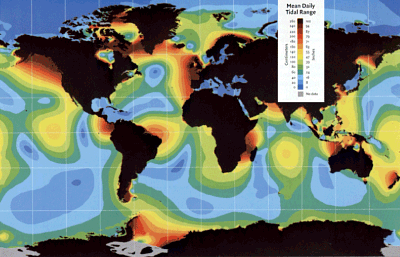
Global distribution of tidal range
Image provided by Electric Power Research Institute (EPRI)
Procurement Considerations
DOE's Water Power Program provides information on water power funding opportunities. The program focuses on research, development, and deployment of ocean technologies capable of generating electricity.
The Federal Energy Management Program (FEMP)'s Guide to Integrating Renewable Energy in Federal Construction has more information on renewable energy project funding options including power purchase agreements, energy savings performance contracts, and utility energy service contracts.
Operations and Maintenance
Ocean thermal energy conversion application typically includes maintenance of machinery and removal of biological growth on submerged sections. The life cycle of a platform for this type of facility is straightforward and has well-established procedures. The ocean thermal energy conversion working fluid pumping systems are commercially available and have a relatively low cost, however, they require significant maintenance. Cable operation and maintenance includes periodic marine growth removal, full cable inspection, and annual maintenance of substations.
Other maintenance costs include replacement parts, component design duty and known service intervals, time to complete service, cost of personnel, and material standby.
Special Considerations
The following are important special considerations for ocean energy systems.
Interconnection
Any electricity power generation facility typically needs to be connected with the local utility power grid. Rules on this vary by state and utility.
FEMP's Integrating Renewable Energy into Federal Construction Guide has more information on interconnection requirements.
Financing of ocean energy systems often makes use of power purchase agreements, where a third-party owns the system and sells the power to the facility. This is a newer model for utilities, and this is not yet allowed in every state by the state's Public Utility Commission.
The Database of State Incentives for Renewables & Efficiency (DSIRE) is a comprehensive source of information on state, local, utility, and federal incentives and policies that promote renewable energy and energy efficiency.
Environmental Review / Permitting
Some of the issues that may be associated with permitting ocean technology facilities include:
- Disturbance or destruction of marine life and marine ecosystems
- Possible threat to navigation from collisions due to the low profile of the wave energy devices
- Degradation of scenic ocean front views.

